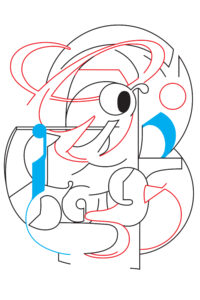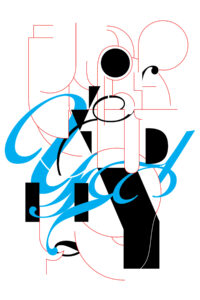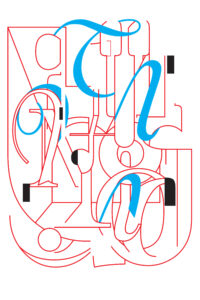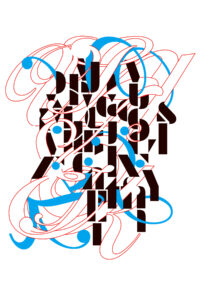If it ain’t broken: a) are you sure, and b) why not?
Dr. Michael Betancourt has been working in experimental forms since 1990. Dr. Betancourt was generous enough to sit down (digitally) with editor Seth Copeland to discuss his work, research, and the fragments in between. Included here alongside a brand new sampling of his visual work is an extensive excerpt from their discussion, in which they cover glitch, “broken” media, archaeology, the early days of digital arts, how the algorithms prevent activism, and why cyan is a great color for vispo.
SC: You had a book come out recently, Glitch Theory: Art & Semiotics. I was curious if you could, for the viewers at home, give us a taste of what glitch theory is.
MB: Well, this is a hard question, mostly because I have to explain things to explain what I mean by glitch theory. A lot of people who work with glitch are concerned with the idea of the machine breaking down as this kind of essential quality. “It’s broken, it’s inherently broken, it’s always gonna be broken, everybody will recognize it as being broken.” This is one of the things that I disagree with most of them about. I think that the recognition of something being broken is entirely relative, that deciding that something is broken depends not on the thing being broken but on the audience encountering it. If the audience says “Oh, this is a glitch” or “This is broken,” it’s broken, period, end of story….which really changes a lot of things. If there’s no longer this ontologically extant category of broken or <glitched, then all the assumptions you might make about something based on that category are wrong. That’s kind of where my thinking about glitch starts, with the idea that glitch is entirely relative to the audience’s encounter. Now, if it’s relative to the audience’s encounter that means it must be in some sense a learned or enculturated product of past experiences.
So, the whole idea of an expressive use of glitch, which is where glitch art comes from–because you take these breakdowns and you use them expressively–the idea gets weird immediately because on the one hand the audience has to say “this is broken” and on the other the audience must also say at the same time that while it’s broken it’s also expressive, and it’s the breakage that’s the expressive part, which means it’s not broken. Cause anything that’s expressive is communicating. It’s been encoded. It has significance. And so it can’t be broken. So we immediately encounter what seems like a paradox, but which I think is kind of a superposition of two different ways of encountering about what your encountering, and from that idea is what I call glitch theory. What I’m working at and looking at theorizing in that book is an entire way of approaching interpretation that begins with perception.
SC: Duchamp has that famous quote in which he defends “R. Mutt’s” Fountain and says it doesn’t matter if he makes it with his own hands, he chooses it, creates a new thought for the object. Pivoting over to Barthes, the “I” that approaches the text is already multiple selves, and when you sit down and read it, it’s never closed, but there is a certain POV that one comes at when looking at these things. Now, I wanted to ask: your father was an archaeologist, right?
MB: Still is.
SC: Still is! Good for him, excellent. I read [your] interview with Malcolm Fernandes where you had talked about that and spending time some w/ him in Crete on Minoan excavations. The thing that comes to mind with excavations is ostraca, bits and pieces….
MB: Excavations are, to be brutally honest about them, less Indiana Jones and more Ken Burns. Very long, very very detailed. Not a lot happens in any given moment,
SC: A lot of tedium, the piercing together, because very often you hit limits, right?
MB: Oh yeah. There’s limits on time, there’s limits on resources, there’s limits on what science can do, so you excavate this part and you don’t excavate that part because you want to leave it for fifty years from now. Archaeology is science much less than adventure.
SC: Probably very frustrating, too, when you hit these limitations.
MB: Well, it’s detailed work. You’re basically excavating with a toothbrush. You excavate through trash because generally the houses that people live in have been looted, and are empty. You excavate their trash heap, because everything from a society that isn’t usable gets put there.
SC: How much would you say your exploration of glitch has to do with the idea of “postmodern” trash?
MB: I’ve never really thought of glitch like that. I’ve never really thought of myself as postmodernist even though I grew up in that period. I was always trying to look beyond it to something that would come next. It’s now what’s called “the contemporary,” which I’m not really happy with as a term because there’s so much. I think of myself more as a kind of marginal artist rather than as a modernist artist, somebody who works at the margins. This is why I call what I do research art rather than commercial art, because I make things but generally they’re not commercial objects. They’re not commodities. They don’t sell in galleries. There’s not a whole lot of interest in what I do, except from other artists and maybe critics and historians. For the most part, the things that I’m doing are driven by, for lack of a better word…I guess you have to call them abstract or theoretical concerns. The kinds of things I’m doing with semiotics are less postmodern and more with the people who come after, people like Roy Harris who make the argument that signs are kind of sign functions, and he’s building on things that Umberto Eco was noting in the late 70s, and even though Eco is, in a sense, the guy who launched the open text movement, his book Theory of Semiotics reins that back and then he reins it back more in his later work in the 80s and 90s, making for a much more constrained argument about interpretation, rather than the kind of unbounded free-for-all that someone like Roland Barthes or Foucault would argue for, or even Lyotard for that matter. It’s more considered, in some ways, [Eco’s] later work. I’m more in line with that.
SC: I know that a lot of your research has to do with digital capitalization, so: the trends we’re seeing now with NFTs and .eth…what’s that all about?
MB: Well, it’s just people trying to commoditize digital work. It’s really just about commodity function, creating artificial scarcity. A lot of this work has very little interest beyond a commodity, but that’s true for most art that’s sold in galleries, too, so it’s not a criticism, it’s simply a fact. At some point the important works will get sorted out or someone will decide there aren’t any important works, or that the technology itself is the important thing and the works that are executed with it are of lesser significance, or the social networks that support some of these things, because some of these very marginal things that don’t trade for a lot of money have enormous social networks around them, and it might be that the social relation is the really important part. It’s also very new; I mean, yeah, it’s been 10 years, but it’s still very, very new. We’ve already had one huge bubble in it where there were some really spectacular winners and a lot of really spectacular losers. It’s just too early to tell.
<SC: You’ve been “in the game” since 1990. I myself became aware of a lot of these [digital arts] terms, like datamoshing and the very idea of glitch during that brief golden bubble of tumblr. In an age before those platforms [were] available, what was it like working in glitch art, say, in the Nineties?
MB: There were two things that were happening in the Nineties with working with this sort of stuff. First, it was almost impossible to show because you’d send somebody a tape that had something that was glitched on it and they’d send you back a tape and say “Something’s broken.”
SC: [laughs] Back to the breakage, yeah.
MB: Even if you have explanations, even if you have text, even if you tell them “There is nothing wrong with this,” they’ll send it back saying “This is broken.” It was that way until 2007-008, to be honest. I had curators return DVDs to me saying “The dvd, it plays all scrambled.” I’d put it on, I’d look at it, and say, “Yeah that’s what it looks like.” It was just very, very hard to get any of this work shown, and for those of us who were in those first couple of generations, and there were a couple of generations, this kind of work was difficult, largely isolated, and mostly driven by what you might call friendship associations, so it was groups of people who knew each other in the real world, not through the computer. And when something would happen, something major, for example, like the Motherboard Conference, it was in Europe, and if you were in those circles you heard about it. If you weren’t in those circles, you heard about it after the fact, and that’s how things were into very, very recently. A lot of what’s changed is the recognition that this is a thing, which didn’t really happen until 2009-2010. That was really the moment when it suddenly emerges, and it emerges I think mostly because of social media, because of Facebook more than anything. There was a flickr group in 2004, there was a scene in Chicago, there was a scene in Miami. There were a couple of scenes in Europe. Very often these were overlaps with music; so people who are doing electronic music are also very often interested in things going on with the visuals, and people doing things with visuals like me end up meeting the people doing things with music, and you get some weird overlaps and conversations there with people who are doing very, very different things. In Miami, there were basically four of us who were doing things like this on a regular basis. We all knew each other.
Before Art Basel came to Miami, the Miami art scene was very provincial. The people doing experimental things tended to know each other very well because there was no one else in the city you could talk to or show your work to. There was nowhere to show it; you just ended up showing it to each other in your living room. In 2001 and 2002, Elizabeth Hall and I had a screening series that showed a lot of this work, and we brought in some really exciting people from outside Miami who were doing interesting things. All of this was visual/video art stuff.
All of that kind of comes to a screeching halt by about 2005, in Miami at least. Things changed in the mid-2000s. A lot of the people left and the scene just kind of moved on. I’m sure there’s still a scene there, but it’s not gonna be the same. I know some of the people involved are still there because they were institutionally connected, but a lot of the people who are on the edges are elsewhere now, including me. It’s just how it goes; things changed. But that moment in the Nineties was the moment when a lot of these things crystallized. You get Kim Cascone writing his article [“The Aesthetics of Failure” in Computer Music Journal, 2000], you get really extreme overlaps between visuals and glitches and the idea of glitch becomes a thing. Up to that point, it was talked about as “digital materiality,” doing these with the material substance of the digital, and that was the idea that a lot of us started with. By the end of the Nineties it was starting to turn into its own thing, which is why the Motherboard Conferences crystalized a lot of that, but that’s also a couple of years afterwards and on the other side of the dot com collapse, so a lot of the being-born platforms for people to talk to each other had all died.
SC: There’s that “dead internet” theory…[that the Internet is entirely] algorithmically driven…
MB: The real problem is there are still real people out there doing things, but they’re being pushed completely beyond the margins. Instead of being allowed to exist around the very edges, they’re now not allowed on the edges anymore, because the algorithms no longer present those edges to anyone unless you pay to become visible. That Internet that’s being born is going to look more like broadcast television of the 1960s where you have a few very large corporations essentially controlling all the information channels and really restricting what people see. Even if it’s still user-generated content like so much of the Internet is today, it would still be like you only watch your favorite information, and you only ever get your favorite information, and you only ever get more of what you’ve already seen or already liked or already engaged with. This is simply an exaggeration of where we are now, and it also means that the people like me who are still doing things become even less visible, and that’s the real problem.
If you look at something like social networking: back in 2010, social networks were the big new technology, and in a lot of ways they were really uncontrolled and unrestricted because the technology was still new and still being developed. One of the most immediate impacts that social networks had were a whole series of political protests starting with the Arab Spring in 2009 and culminating in Occupy Wall Street in 2011. By 2012, the technology had been tweaked sufficiently to prevent this from happening again, and the way you tweak it to prevent it from happening again is that you simply don’t serve people things simply because they’re popular, trending or prominent; you only serve them things that are that + match their interest. And so, you only tell people what they want to hear, and in the past decade this has become even more powerful. This is what the Cambridge Analytica scandal was about in 2016: the atomization of the audience and then the microtargeting of them, so that you deliver exactly the message you need to make that single individual do what you want them to do in order to deliver the behavior that you’re interested in. Now, imagine that’s been automated instead of having to be done by humans: that’s AI.
SC: I think of Deleuze and the whole concept of the control society. One of the examples is a freeway, right? The idea is “you can go anywhere!” But obviously, you can’t go off the side of the road. That’s the Internet getting bigger and getting smaller at the same time, and making it harder for that kind of [activist] organization in the post-Arab Spring/post-Occupy milieu.
MB: In a way, it’s easy to happen, but it’s also difficult to spread. What made Occupy powerful is that it spread like a virus. The Arab Spring spread like a virus. That doesn’t happen now. What you get is a virus spreading within a predefined community who are already susceptible to agreeing with it. We’re not completely at that point of enclosure, but we’re moving toward it very, very rapidly. I think the model for this is not so much the control society as it is the enclosure movement three hundred years ago, where all the commons get broken up into these privatized pastures where you have no access and only those who are allowed inside that space are inside that space. There are lots of models for this saying AOL was this back in the 90s; that’s what CompuServe was back in the 80s, private walled gardens where people didn’t venture outside. The difference between then and now is that back then people would pay for that experience, and now people are looking for and voluntarily embracing it and complaining when they don’t get it, which is the exact opposite of the 1990s, because everybody hated America Offline.
SC: Everything old is new again.
MB: Well, nothing changes. The model adapts.
MB: It’s much simpler than that. It’s a collage.
SC: Oh! I wrote down “collage might not be the right word,” but that’s great!
MB: I’m working with contemporary design software where you can take typography, and you can convert it into a graphic. When you convert it into a graphic, what you have is a vector outline that you can cut & paste, manipulate, erase parts of, combine with other pieces, and so it really functions like collage, only it’s a fully digital collage and what’s being collaged are the cues that we use to identify language.
There are four typefaces; they are all Latin typefaces. So, no matter what happens it’s going to be familiar, legible characters that you would otherwise be able to read, which is why it works for people who speak English. You look at it, you recognize things that are enough like English that you’re like “Oh, yeah, that…no, that’s not English. Well, is that an E or is that an A? What letter is that?” Then you look somewhere else, it turns into a letter, and you look back and it stops being a letter.
SC: It’s a bit uncanny, yes.
MB: Yep. And that’s by design. Really, all of the art of the production is creating that effect. That’s what makes them typoems, that’s what makes them asemic. They’re balanced precariously on that knife edge between being fully legible and being completely illegible, decomposing into things that aren’t letters at all. The uncanny is [that] the weirdness happens because it’s making that shift right around the periphery of where you’re looking.
SC: Even if [you] don’t entirely understand what [you’re] looking at, whatever that means, you feel something and there’s a familiarity, and also a distance.
MB: What I’ve noticed is that the things I’m doing with language are in the same category as metamorphic images where you have two pictures at the same time in a picture, that whole category of unstable images where what you’re seeing isn’t entirely what you’re seeing. This kind of experience can be either of great interest and people get very excited about it, or it can be very destabilizing and very upsetting to some people.. It doesn’t really have a middle ground. You’re not ambivalent about it. You’re not just like “Eh, yeah, it’s a thing.” No [laughs], you either like it or you don’t! I’ve had people look at these and tell me they give them headaches.
SC: And are you like, “Great!” Or? [laughs]
MB: It’s an interesting response! I’m curious why it would be causing a headache, but okay. It’s certainly a response.
SC: Blue is a very prominent shade [in these images]. Is it purely an aesthetic choice, or?
MB: Well, it’s processed blue. Technically, it’s processed cyan, because blue is darker. In terms of colors, generally when I am coloring things directly. I go for processed color, spot color, because compositionally they’re easy to use and then you can swap them. Some of my more recent work that is doing things with color is very, very different, because I’m not using spot color but the vector capacities of the shapes and forms I’m creating to create masks. Sometimes, they’re animated. Working with spot color is relatively straightforward when you’re running a typesetting program because–and these were all made in Adobe Illustrator–it’s simply one of the simple capacities of the program. I know it can do much more dynamic and complex things, but I don’t necessarily want to do those. These are very flat, in the same way typography is flat. As soon as you start putting color in, it becomes pictorial, and it stops acting like typography. Dynamically colored, irregular, is very hard to recognize as type easily.
SC: Yes, it complicates immediate interpretation, so to speak.
MB: Yeah. That’s one of the concerns I have with this work. There are multiple ways in which this very precarious balance I’m trying to maintain can collapse. Those collapses, every single one of them, feels like a diminishment, a stepping away from what makes this so complicated and interesting.
SC: A lot of this journey for you began with a happy accident in 1990. How much do you feel that still plays a role in your active process?
MB: Well, you have to be looking for things to happen in order for them to happen. I’ve always liked Pascal’s idea that chance favors the prepared mind. If you’re not looking for it, you’re not going to find it. For digital breakdowns, glitch, I was looking for it in 1990. I wasn’t necessarily anticipating it in a positive sense when it happened, but I was looking for it, so when it happened, I was prepared for what happened. At least from my perspective, you always have to be prepared to stop and say “Okay, I didn’t want that. Is this better?”
SC: When the cynics talk about ephemerality of digital work and have these doomer claims about it all being lost in some future cataclysm: do you have a response?
MB: Who needs the future cataclysm? You could lose it tomorrow. Drop your computer on the floor, and it’s all gone. So, everything is ephemeral. The oldest art objects we have are 40,000 years old; they’re about three inches high, little tiny statues. We don’t know what they mean. And yet when we look at them today, like the Willendorf Venus, they are definitely art objects. They have all the things that we want art to have. Now, these things are products of a culture. You don’t make this thing in isolation by itself. The culture is gone, but who cares? The people who were living in it were living in it; it was their world, and if you worry that everything is eventually going to go away, remember that in about 5 billion years the sun will burn out and everything will be gone. So, it’s like, [laughing] what timeline are we talking about?
SC: [also laughing] It’s always already going away.
MB: Sure, digital is ephemeral, but so is painting. We just had a huge wildfire run through a big chunk of the West. Completely obliterated people’s houses. How many art objects were in those houses?
SC: God. How many toothbrushes?
MB: Yeah, exactly. Everything passes away. It’s not about permanence or ephemerality from my point of view, and in that regard, the digital is no different from anything else. It’s about the culture around, the response and experiences you have when you encounter it, the things that you do with it, what it does in a bigger sense n the culture around it and how it fits into all that. So, if the worry is “oh this is ephemeral, it’s going to pass away,” yeah, so what? Maybe that’s a good thing. Do we really need to remember every second of everyone’s lives forever? Do we really need to have all the stuff that anybody could produce being maintained because it might someday be valuable to someone, especially when most of that valuable is for marketing. When it becomes simply unpaid labor to build an AI system, do we really care if it survives? And, maybe going away is a good thing. There’s a reason that the avant gardes 100 years ago wanted to destroy everything and the Futurists talk about burning the museums. Remember, Futurism comes from Italy, where they have this vast collection of museums literally everywhere and you can’t dig a hole in the ground without finding something ancient. So, perhaps their desire to liquidate the past was partly a desire to create room for the future.
Glitch Theory: Art & Semiotics is available from I’m Press’d.
Michael’s personal website can be found here.






